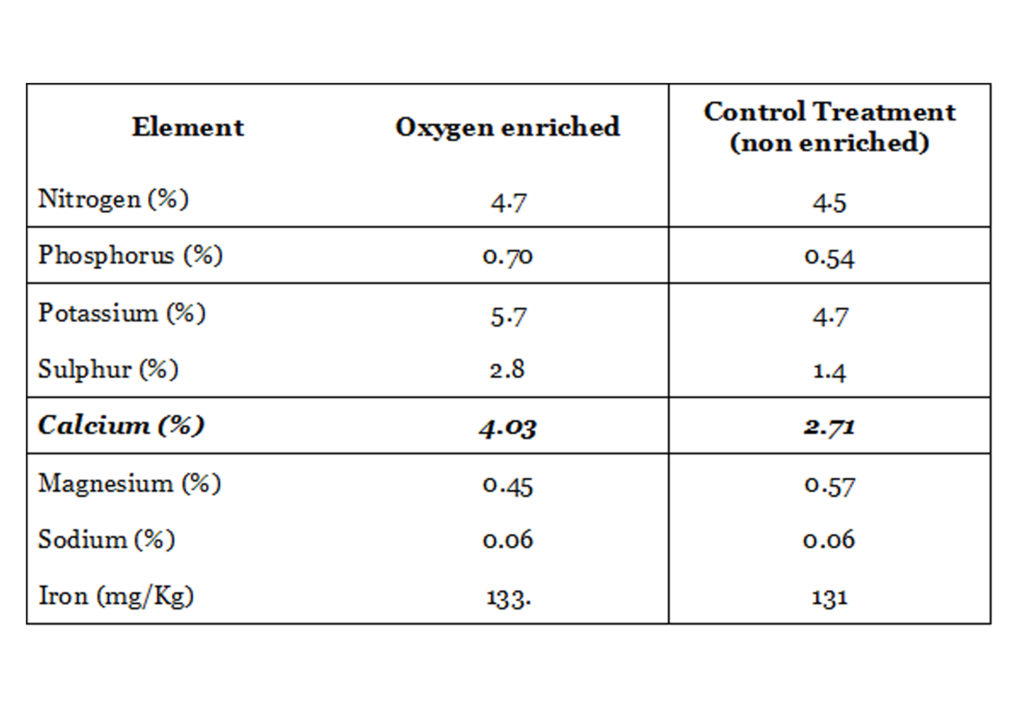Effect of Oxygen Enrichment
in the Root Zone in Crops
Progressive farmers have now become well aware and focused on the effects of plant nutrition, water status and the climatic environment on crop growth and yields. While commercial crops are generally provided with necessary precision farming inputs required for maximum production, one vital aspect is very often overlooked: oxygen in the root zone.
We are all aware that a plant’s root system requires oxygen for the process of respiration. Root respiration is essential to the plant process as it releases the energy required for root growth. This results in increased absorption of minerals from the soil or nutrient solution. Nature’s way is that healthy roots, when supplied with sufficient oxygen, will be able to selectively absorb nutrient ions from the surrounding soil solution as and when required. The metabolic energy required to drive this process of ion uptake is largely obtained from root respiration. The limiting factor for this process is oxygen starvation. In fact, in a low-oxygen anaerobic environment, there can be a net loss of nutrient ions from root systems.
Oxygen in the Root Zone
In field crops, oxygen enters the plant roots in two ways:
- Through the pores between soil particles which are filled with air pores (where oxygen is present)
- Oxygen is also absorbed by the plant roots as they come in contact with water in the soil, either rainwater or irrigation water
The various factors which determine how much oxygen is available to the root system are:
- soil compaction,
- soil type and structure,
- amount of humus,
- moisture content ( saturated soils hold little plant-available oxygen),
- the microbe populations present in the soil
- the amount of dissolved oxygen present in irrigation water.

The deeper we go into the soil, the lesser the oxygen levels. Microbe populations will also compete with plant root systems for the limited amount of oxygen available in the soil system. Further, in warm and tropical climate zones, the demand for soil oxygen is much greater. This is more critical as the plants mature at flowering and fruiting phases, when the oxygen requirements in the root zone reach peak demand. Therefore, it becomes very important to search for ways to replace oxygen, especially in the root zone.
Typically, our soil or nutrient solutions hold only relatively small amounts of dissolved oxygen at saturation, in the range 4 -13 ppm, depending on soil temperature. This is depleted rapidly with an actively growing crop. The best way to replenish this oxygen depletion and boost oxygen levels in the root zone is to super-saturate the irrigation water or the nutrient solution with oxygen so that fresh supplies of dissolved oxygen are available to the plant root zone on a regular basis. This needs to be at a level high enough to compensate for any oxygen depletion and boost growth, development, mineral uptake and overall plant health.
Oxygen and Calcium Uptake – Blossom End Rote
Various trials have found that plant growth, in general, increases with higher oxygen levels in the soil. Furthermore, a substantial amount of research has shown that aeration or oxygenation conditions influence ion accumulation and content of plant tissue. Oxygen deficiencies within the root zone have long been linked to a higher occurrence of blossom end rot. Since this condition results in a high percentage of fruit rejection in many crops, it becomes important to study and prevent this disease.
BER is a common problem in fruit and vegetable crops, especially under warm tropical growing conditions. Certain environmental conditions such as high temperatures and high humidity levels, and soil conditions such as high EC or salinity in the root zone, deficient irrigation, root disease pathogens and nutrient imbalances which restrict nutrient uptake and transpiration problems within the plant may result in Blossom End Rot disease.
BER is also well known to be linked to plant root water uptake, as calcium, (the contributing factor in BER occurrence) travels within the xylem vessels or transpiration stream within the plant. Thus oxygen enrichment in the root zone which results in better nutrient uptake appears to be one way to limit BER occurrence in crops prone to this problem.
Calcium (Ca) is the main plant nutrient most affected by a lack of oxygen in the root zone. Unlike the other major nutrients, calcium is absorbed primarily through root apices or growing tips. The root apex has a large energy requirement for new cell production and therefore any oxygen stress directly affects its growth. If an increasing number of root apices begin to suffer from an oxygen deficiency, a shortage of calcium in the shoots becomes more likely.
Field studies have shown that oxygen deficiency of roots seems to be an important factor that determines the occurrence of Blossom End Rot or BER. BER is also directly linked to calcium deficiency in plants. Thus boosting oxygen levels in the root zone will assist with calcium transportation into the shoots and the prevention of BER, particularly under plant stress conditions.

Oxygen in the Root Zone and Pathogens
Attack by root rot pathogens is common in crops. In most cases, these diseases are opportunist and will only infect and destroy already weakened root tissue. Pathogen studies have established that after inoculation with Pythium, plant roots in oxygen- enriched root zones continued to remain healthy. In contrast, plants grown in low oxygen treatments began to show the typical signs of root decay and infection within six days of inoculating with Pythium. The results from this study clearly demonstrate that oxygen concentration in the root zone has a significant effect upon the development of Pythium root rot of plants and that colonisation of roots by the fungus could be reduced by root zone oxygen enrichment.
Similar results have been found for infection with Phytophthora root rot. Again, these results indicate that low oxygen can predispose root systems to diseases caused by root rot pathogens and that high levels of oxygen around the root zone ensure a healthy root system which can resist attack by opportunist pathogens.
It was also found that in addition to increased severity of root rot, low and moderate oxygen levels resulted in a significant reduction of root and shoot growth of tomato plants, regardless of Pythium infection.
Oxygen Enrichment and Nutrient Uptake
Plant growth studies with increased oxygen levels in the root zone have shown that main root and total root lengths and the number of root hairs, length of root hairs and length of the root hair zone in the area around the root top were much improved. It was also found that the photosynthetic rate and root respiration increased with increasing oxygen concentration.
Higher dissolved oxygen levels in irrigation water or nutrient solutions promoted the uptake of phosphate and also increased plant height, fresh weight of stems and leaves as also root weight. It also increased the phosphorus concentration in the sap, stems, leaves and fruits of plants. It has also been reported that rates of uptake of nitrogen, phosphate, potassium and water were higher in plants grown in aerated (high levels of dissolved oxygen) solutions.
Mineral analysis of the foliage of oxygen-enriched crops compared to non-enriched control crops (Table 1) demonstrates that nitrogen, phosphorus, potassium, sulfur, calcium and iron all increased in the plant foliage with oxygen enrichment in the root zone as compared to the control plants which received no oxygen enriched irrigation.
However, it is to be noted that Magnesium levels in the oxygen-enriched plants are likely to be lower than the control (non-oxygen-enriched plants) as there is an inhibitory effect on magnesium uptake when high levels of potassium are accumulated in the foliage (oxygen-enriched potassium levels are higher than the control).

Conclusion
Studies suggest that crop performance levels can be enhanced with the use of technology to enrich oxygen levels in irrigation water or nutrient solutions. The way forward for increased crop yields without chemical contamination is enriched oxygen in the root zone in the same way carbon dioxide enrichment is commonly used in the greenhouse environment to boost growth and yields.
- +65 98522454
- info@pranasaara.com
Icons from www.flaticon.com

